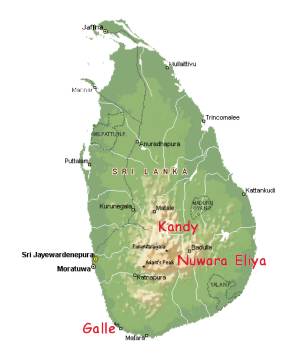|
Journal
Galle
Contact Us
Poems
Site Map
Search
| |
 At
a crossroads of maritime routes traversing the Indian Ocean, Sri Lanka (Ceylon)
has also been exposed to cultural influences from other Asian civilizations1 At
a crossroads of maritime routes traversing the Indian Ocean, Sri Lanka (Ceylon)
has also been exposed to cultural influences from other Asian civilizations1
 Overview: Overview:
The distinctive civilization of Sri Lanka, with roots
that can be traced back to the 6th century BC, is characterized by two factors:
the preservation of Theravāda Buddhism and the development over two millennia of
a sophisticated system of irrigation in the drier parts of the country. This
civilization was further enriched by the influences of Hinduism and Islām.1
Most cruisers who stop at Sri Lanka check into
Galle and then travel inland to the highlands to see the scenic tea
plantations that produces some of the world's best tea and the Elephant
orphanage near Kandy.
General Information
| Country Code: |
94 |
|
Time Zone: |
+6 hours from UTC |
|
Currency:
|
Sri Lankan Rupee |
 Check
In Check
In
Check In Procedures - These were the
procedures in Galle when we checked in in January 2003.
-
When you are about 1-2 miles out,
call 'Port Control' on channel 16 and let them know
that you are approaching the harbor. (If you arrive at night
you may enter the outer harbor and anchor around 'Watering Point'
until morning.) Port Control does not open until 9am Sri Lanka
time.
-
Proceed in and anchor in the north
end of the outer harbor near a small white cone. You will
see 2 breakwaters into the inner harbor to the east. Call
'Port Control' and let them know that you have anchored.
-
The Navy will send out Naval
personnel in a wooden launch. (Make sure that you have plenty
of fenders out as there is usually a small swell and it is difficult
to keep the wooden boat away from the hull.) They will board
your boat and perform a cursory check for contraband and
explosives. (It is probably best to stow loose items such as
cameras, sunglasses, liquor, small radios, etc. so as not to attract
undue attention.) When they came onboard Long Passages, they
asked us to open our lockers, but did not empty the contents.)
You will need to give them a crew list. Once they are
finished you may enter the inner harbor, if you desire.
-
Enter the inner harbor through the small
opening between the right breakwater and the small buoy.
The left 3/4 of the entrance between the 2 breakwaters has a submarine
net running across it, so DO NOT enter through that opening.
-
There are several mooring options inside
the inner harbor:
-
You may tie up bow and stern
between a buoy and the pontoon located behind the right
breakwater. Unfortunately the pontoon does not give you access
to land. It is advisable that you also drop an anchor as the
integrity of the buoy attachment is suspect.
-
You may tie up along the ship dock
at the NW end of the harbor, although the dock is very high and
you must climb up on a large fenders to reach the top.
-
You may drop an anchor at the
north end of the harbor and run stern lines ashore so that you
do not swing.
|
-
You may now go ashore. Call one
of the agents, either Windsor (channel 69) or GAC (channel 71)
and arrange to come in and complete your check in.
-
Make your way to the Naval Base
entrance (with the swing gate) located along the road at the NE
end of the harbor. Tell the guard that you are checking in and
need to see the agent (either Windsor or GAC). They will
assign someone to escort you to the office.
-
The agent will check your
passports, ship's papers and clearance papers from your previous
port (zarpe) to ensure that everything is correct. They
will fill out most of the required forms and ask the ship's master
(captain) to sign them. The charge in 2003 was US $170 for
Windsor and US $200 for GAC. They will provide a written
receipt which breaks down the charges. In 2003 the harbor and
custom's fee was US $120 for a 30-day stay, the rest of the money
being the agent's fee.
-
You will then be escorted to the immigration
office where your passports are checked and stamped.
-
Next, you are escorted to the customs
office where you will fill out a custom's declaration form stating
the type and quantity of certain items that are on the boat.
If you have firearms, you will need to declare them. The
custom's agent will need to visit the boat to inspect the weapon and
if you have a secure place to keep it, they will place a seal across
the opening that will be inspected when you leave to insure that the
locker has not been opened during your stay. The custom's
agent almost always visits the boat anyway, so again best to stow
loose small items and liquor. When they visited our boat, the
'junior' member of the team did ask for cigarettes, liquor,
etc. We did NOT give but did offer a cold soft drink which was
accepted. The visit to the yacht is usually arranged sometime
later in the day.
-
After customs you will be guided to
the Naval guard office where they will issue you a pass that
enables you to leave and re-enter the facility. You must show
the pass when either leaving or entering and all bags and packages
will be inspected both ways.
|
1Information obtained from Encyclopedia
Britannica |